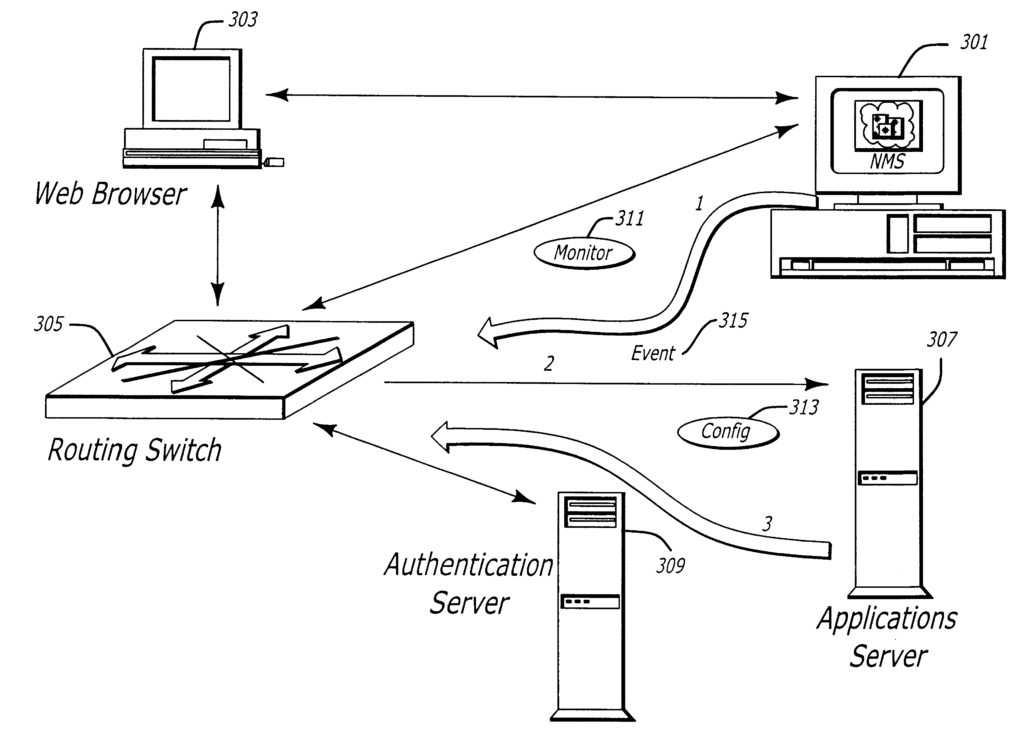ABSTRACT
A method and apparatus for automatically configuring a network switch having external network data ports, a processor, memory, data bus, and co-processor.
Network data is monitored on the external network data port. Information about the network data traffic is compared to one or more threshold conditions. The network switch is automatically configured by the co-processor if the network data meets one of the threshold conditions. The monitor and configuration functions can be performed by software running on the co-processor which has been downloaded from an external network maintenance station through a maintenance data port. Information about the network data traffic can be uploaded to the external network maintenance station through a maintenance data port.

Network apparatus with Java co-processor
An Inventor: Dr. Tal Lavian
FIELD OF THE INVENTION
This invention relates generally to data communications networks, and more particularly, to a method and apparatus for automatically configuring a network switch with a co-processor.
BACKGROUND OF THE INVENTION
Computer networks are used to interconnect many computing resources, including computers, workstations, servers, printers, modems, and storage devices.
For example, two or more computers may be connected together through a network. Network users are able to share files, printers and other resources, send messages and run applications on remote computers. An important part of any computer network includes the physical components or network communications devices used to interconnect the computing resources.
One network communications device used to interconnect multiple computing resources is a chassis-based system designed to accommodate a number of internal cards. The computing resources such as computers are coupled to the internal cards of the chassis-based system. Once the computers are coupled to the internal cards, the computers are coupled to the network. To accommodate network growth, additional internal cards may be purchased and added to the chassis-based system. With the additional internal cards installed, additional computing resources may be added to the network. A disadvantage of these chassis-based systems is that there is a relatively large initial investment when purchasing the chassis because of the large amount of overhead associated with chassis-based systems.
An alternative to expensive chassis-based systems is the use of less expensive standalone network communications devices or units that have a fixed number of ports for connecting computing resources or stations to the network. Such standalone network communications devices include stackable switches or the like. Although additional ports can not be added to each individual standalone unit, separate standalone units can be stacked, cascaded or coupled to accommodate network growth. As a result, there is a lower startup cost when establishing a computer network with the standalone units in comparison with chassis-based systems. Furthermore, network administrators still have the flexibility to increase the size of the network with the less-expensive standalone units.
FIG. 1 illustrates multiple network communications devices 103, 105, 107, 109 and 111 coupled together to form a computer network 101. Multiple computing resources (not shown) are coupled to each network communications device 103, 105, 107, 109 and 111. In one embodiment, network communications devices 103, 105, 107, 109 and 111 are stackable switches coupled together through bus 113. Bus 113 is used to tie together the switch network fabric of computer network 101. It are noted by one of ordinary skill in the art that the utilization of bus 113 is an extension of the chassis-based designs discussed earlier. The internal cards of the chassis-based systems are commonly coupled to high speed buses within the chassis-based systems.
The use of stackable switches allows network administrators to build systems having multiple physical ports to various computing resources on the network. Different types of network use patterns may typically be handled most efficiently by different configurations of a network switch. Currently, a network administrator must manually monitor and analyze network traffic patterns, and also manually make any changes to the configuration of a network switch through the use of an external network maintenance station (NMS). Although some network switches may have data gathering and reporting capabilities, a network administrator must still take a considerable amount of time to analyze the network traffic pattern and manually reconfigure the switch. Delays in rerouting network traffic are directly related to the time required to analyze network traffic and reconfigure a network switch by a network administrator.
Therefore, there is a need for a way to automatically monitor and configure a network switch according to changes in network traffic. There is a further need to automatically configure a network switch which does not reduce the flow of data through the switch.
SUMMARY OF THE INVENTION
The present invention provides a method and apparatus for automatically configuring a network switch having external network data ports, a processor, memory, data bus, and co-processor.
Network data is monitored on the external network data port. Information about the network data traffic is compared to one or more threshold conditions. The network switch is automatically configured by the co-processor if the network data meets one of the threshold conditions. The monitor and configuration functions can be performed by software running on the co-processor which has been downloaded from an external network maintenance station through a maintenance data port. Information about the network data traffic can be uploaded to the external network maintenance station through a maintenance data port.